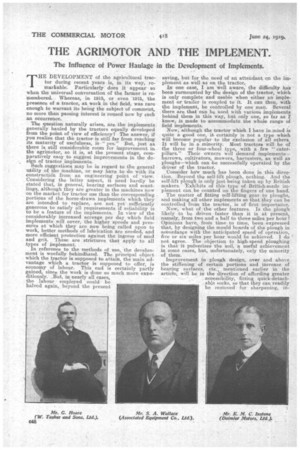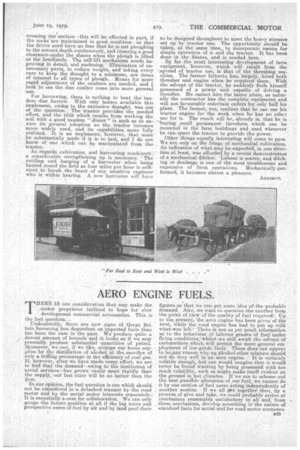THE AGRIMOTOR AND THE IMPLEMENT.
Page 34

Page 35

If you've noticed an error in this article please click here to report it so we can fix it.
The Influence of Power Haulage in the Development of Implements.
THE DEVELOPMENT of the agricultural tractor during recent years is, in its way, remarkable. Particularly does it appear so when the universal conversation of the farmer is remembered. Whereas, in 1913, or even 19M, the presence of a tractor, at work in the field, was rare enough to warrant its being the subject of comment, no more than passing interest is roused now by such an occurrence.
The question naturally arises, are the implements generally hauled by the tractors equally developed from the point of view of efficiency? The answer, if you realize that the tractor is still far from reaching its maturity of usefulness, ik " yes." But, just as there is still considerable room for improvement in the agrimotor, so it is, at the present stage, comparatively easy to suggest improvements in the design of tractor implements.
Such suggestions may be in regard to the general utility _of the machine, or may have to do with its constructich from an engineering point of view. Considering the latter aspect, it need hardly be stated that, in general, bearing surfaces and scantlings, although they are greater in the machines now on the market for tractor use than the corresponding portions of the horse-drawn implements which they are intended to replace, are not yet sufficiently generous to satisfy all requirements if reliability is ta be a feature of the implements. In view of the considerably increased acreage per day which field implements will cover, the higher speeds and pressures at which they are now being called upon to work, better methods of lubrication are needed, and more efficient protection against the ingress of mud and grit. These are strictures that apply to all .types of implement. .
In reference to the methods of use, the develoument is woefully behindhand. The principal object which the tractor is supposed to attain, the main advantage which a tractor is supposed to offer, is economy of labour. This end, is certainly partly gained, since the work is done so much more expeditiously. ,But, in nearly all cases, the labour employed could be halved again, beyond the present
saving, but for the need of an attendant on the implement as well as on the tractor. In one ease, I am 'Well aware; the difficulty has been surmounted by the design of the tractor, which is only complete and usable when either an implement or trailer is coupled to it. It can then, with the implement, be controlled by one man. Several there are that can he used with various implements behind them in this way, but only one, so far as I know, is made to accommodate the whole range of field implements. .
Now, although the tractor which I have in mind is quite a good one, it certainly is not a type which will become popular to the exclusion of all others. It will be in a minority. Most tractors will be of the three or four-wheel type, with a few " caterpillars." Their owners will demand implernents harrows, cultivators, mowers, harvesters, as well as ploughs—which can be successfully operated by the driver of the tractor.
Consider how much has been done in this direction. Beyond the self-lift plough, nothing. And the self-lift plough is only just being taken up by British makers. 'Exhibits of this type of British-made implement can be counted on the lingers of one hand. The matter of fitting self-lifting gear to ploughs, and making all other implements so that they can be controlled from the tractor, is of first importance.
Now, what of the other features. Is the plough likely to be driven faster than it is at present, namely, from two and a half to three miles per hour? Opinions have, from time to time, been expressed that, by designing the mould boards of the plough in accordance with the anticipated speed of operation, five or six miles per hour would be achieved. I do not agree. The objection to high-speed ploughing is that it pulverizes the Soil, a useful achievement in some cases, but, unfortunately, only the minority of them.
Improvement in plough design, over and above the stiffening of certain portions and increase of bearing surfaces, etc., mentioned earlier in the article, will be in the direction of affording greater accessibility, fitting quick-detachable socks, so that they can readily be removed for sharpening, in
creasing the/suction—this will be effected in part, if the socks are maintained in good condition—so that the driver need have no fear that he is not ploughing to the correct depth continuously, and ensuring a good clearance.under the shares when the plough is lifted at the headlands. The self-lift mechanism needs improving in detail; and enclosing. Elimination of unnecessary parts, to reduce weight, and taking every care to keep the draught to a minimum, are items of interest to all types of plough. Means for more rapid adjustment of the coulters are needed, and I look to see the disc coulter come into more general use.
For harrowing, there is nothing to beat the tandem disc harrow. With only horses available this implement, owing to the excessive draught, was out of the question. The tractor provides the needed effort, and the tilth which results from working the soil with a good tandem " discer " is such as to ensure its general adoption as the tractor becomes more widely used, and its capabilities more fully realized. It is an implement, however, that must be substantially made if it is to last, and I do not know of one which can be manipulated from the tractor.
As regards cultivators, and harvesting machinery, a considerable strengthening up is necessary. The rattling and banging of a harvester when being hauled round the field at four miles per hour is sufficient to break the heart of any sensitive engineer who is within hearing. A new harvester will have to be designed throughout to meet the heavy stresses set up by tractor use. The opportunity should be taken, at the same time, to incorporate means for simple operation of it and the tractor. It has been done in the States, and is needed here. By far the most interesting development of farm equipment, however, which will result from the ',spread of tractor use, is that of the threshing machine. The farmer hitherto has, largely, hired both thresher and engine when he required them. With the advent of the tractor, he suddenly finds himself possessed of a power unit capable of driving a thresher. He cannot hire the latter alone, as naturally the contractor has the complete equipment and will not favourably entertain orders for only half his plant. The farmer, too, realizes that he can use his tractor engine for the work when he has no other use for it. The result will be, already is, that he is buying small permanent threshers which can be mounted in the farm buildings and used whenever he can spare the tractor to provide the power.
• Other things equally interesting will come to pass. We are only on the fringe of mechanical cultivation. An indication of what may be expected, in one direction at least, was afforded by a recent demonstration of a mechanical ditcher. Labour is scarce, and ditching or drainage is one of the most troublesome and expensive of farm operations. Mechanically-performed, it becomes almost a pleasure.
AGRIMOT.










































